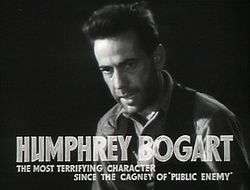Crime film
Crime films, in the broadest sense, are a film genre inspired by and analogous to the crime fiction literary genre. Films of this genre generally involve various aspects of crime and its detection. Stylistically, the genre may overlap and combine with many other genres, such as drama or gangster film,[1] but also include comedy, and, in turn, is divided into many sub-genres, such as mystery, suspense or noir.

Screenwriter and scholar Eric R. Williams identifies Crime Film as one of eleven super-genres in his screenwriters’ taxonomy, claiming that all feature length narrative films can be classified by these super-genres. The other ten super-genres are Action, Fantasy, Horror, Romance, Science Fiction, Slice of Life, Sports, Thriller, War and Western.[2] Williams identifies drama in a broader category called "film type", mystery and suspense as "macro-genres", and film noir as a "screenwriter's pathway" explaining that these categories are additive rather than exclusionary.[3] Chinatown would be an example of a film that is a drama (film type) crime film (super-genre) that is also a noir (pathway) mystery (macro-genre).
Source of plots
Crime films are often based on real events or are adaptations of plays or novels. For example, the 1957 film version of Witness for the Prosecution is an adaptation of a 1953 stage play of that name, which is in turn based on Agatha Christie's short story, originally published in 1933. The film version was remade in 1982, and there have been other adaptations. However, each of these media has its own advantages and limitations, which in the case of cinema is the time constraint.
Plays and films

Witness for the Prosecution is a classic example of a "courtroom drama". In a courtroom drama, a charge is brought against one of the main characters, who claims to be innocent. Another major part is played by the lawyer (in England a barrister) representing the defendant in court and battling with the public prosecutor. He or she may enlist the services of a private investigator to find out what really happened and who the real perpetrator is. However, in most cases it is not clear at all whether the accused is guilty of the crime or not—this is how suspense is created.
Often, the private investigator storms into the courtroom at the very last minute in order to bring a new and crucial piece of information to the attention of the court. This type of literature lends itself to the literary genre of drama focused more on dialogue (the opening and closing statements, the witnesses' testimonies, etc.) and little or no necessity for a shift in scenery. The auditorium of the theatre becomes an extension of the courtroom. When a courtroom drama is filmed, the traditional device employed by screenwriters and directors is the frequent use of flashbacks, in which the crime and everything that led up to it is narrated and reconstructed from different angles.
A classic courtroom drama is U.S. playwright Reginald Rose's Twelve Angry Men (1954), which is set in the jury deliberation room of a New York Court of Law. Eleven members of the jury, aiming at a unanimous verdict of "guilty", try to get it over with as quickly as possible. And they would really succeed in achieving their common aim if it were not for the eighth juror (played by Henry Fonda in the 1957 movie adaptation), who, on second thoughts, considers it his duty to convince his colleagues that the defendant may be innocent after all, and who, by doing so, triggers much discussion, confusion, and anger.
Subgenres
Action crime
A hybrid of action films and crime films and a subgenre of action films as well. Most films of this kind fall in the category of heist films, prison films and sometimes cop and gangster films. Car chases and shootouts are commonly featured. Example include the Police Story franchise, The Dark Knight, Baby Driver, Master, Collateral, and Heat.
Crime comedy
A hybrid and mix of crime and comedy films. Mafia comedy looks at organized crime from a comical standpoint. Humor comes from the incompetence of the criminals or black comedy. Examples include Analyze This, The Pope of Greenwich Village, Lock, Stock & Two Smoking Barrels, In Bruges, Mafia!, Tower Heist and Pain & Gain.
Crime drama
A combination of crime and drama films. Examples include such films as Straight Time and Badlands, as well as television series such as The Sopranos and American Crime.
Crime thriller
A thriller in which the central characters are involved in crime, either in its investigation, as the perpetrator or, less commonly, a victim (generally, this is just a thriller). While some action films could be labelled as such for merely having criminality and thrills, the emphasis in this genre is the drama and the investigative/criminal methods. Examples include Untraceable, The Silence of the Lambs, Heat, Seven, Witness, Memories of Murder, The Call, and Running Scared.
Dacoit film
A genre of Indian cinema (including Bollywood) revolving around dacoity. The genre was pioneered by Mehboob Khan's Aurat (1940) and Mother India (1957). Other examples include Gunga Jumna (1961), Sholay (1975) and Bandit Queen (1994).
Film noir
A genre popular in the 1940s and 1950s often fall into the crime and mystery genres. Private detectives hired to solve a crime are in such films as The Maltese Falcon, The Big Sleep, Kiss Me Deadly, L.A. Confidential, The Long Goodbye, and Chinatown. Neo-noir refers to modern films influenced by film noir such as Sin City.
Gangster film
A genre of film that focuses on gangs and organized crime. Examples include The Godfather trilogy (1972−1990), Once Upon a Time in America (1984), Goodfellas (1990), and The Irishman (2019).
Heist film
This film deals with a group of criminals attempting to perform a theft or robbery, as well as the possible consequences that follow. Heist films that are lighter in tone are called "Caper films". Examples include The Killing, Oceans 11, Dog Day Afternoon, Reservoir Dogs, and The Town.
Heroic bloodshed
A Hong Kong action cinema crime film genre. The genre was pioneered by John Woo's A Better Tomorrow (1986) and Ringo Lam's City on Fire (1987), starring Chow Yun-fat. Elements of the genre can be seen in Hollywood crime films since the 1990s, such as the work of John Woo and Quentin Tarantino.
Hood film
Film dealing with African-American urban issues and culture. They do not always revolve around crime, but often criminal activity features heavily in the storyline. They may include honor killings, initiations, unprotected sex, fights, word play and punch lines, cryptic storytelling, love scenes and blood feuds. Examples include Menace II Society and Boyz n the Hood.
Legal drama
Not usually concerned with the actual crime so much as the trial in the aftermath. A typical plot would involve a lawyer trying to prove the innocence of his or her client. Examples include 12 Angry Men and A Time To Kill.
Mafia film
Film which focuses on characters who are involved seriously with the Mafia or organized crime. Notable mob films include: The Godfather, Goodfellas, Once Upon a Time in America, Bugsy, Little Caesar, The Untouchables, The Public Enemy, Scarface, and The Departed.
Mumbai underworld
An Indian cinema crime film genre, often produced in Bollywood. The genre frequently draws inspiration from real Mumbai underworld gangsters, such as Haji Mastan, Dawood Ibrahim and D-Company. The genre was pioneered by Salim-Javed's Zanjeer (1973) and Deewaar (1975), starring Amitabh Bachchan. Other examples include the Don franchise (1978–2012), Nayakan (1986), Salaam Bombay! (1988), Parinda (1989), Satya (1998), Company (2002), Black Friday (2004), Slumdog Millionaire (2008) and Once Upon a Time in Mumbaai (2010).
Mystery film
Film which focuses on the efforts of the detective, private investigator or amateur sleuth to solve the mysterious circumstances of a crime by means of clues, investigation, and clever deduction
Police procedural
Police procedurals have remained a mainstay with He Walked By Night, In the Heat of the Night, Madigan, and The French Connection.
Yakuza film
Japanese crime film genre. Examples include Abashiri Prison, Branded to Kill, Battles Without Honor and Humanity, and Sonatine.
See also
References
- "Metasearch Search Engine". search.com. Retrieved 2019-01-18.
- Williams, Eric R., (2017). The screenwriters taxonomy : a roadmap to collaborative storytelling. New York, NY: Routledge Studies in Media Theory and Practice. ISBN 978-1-315-10864-3. OCLC 993983488.CS1 maint: extra punctuation (link) CS1 maint: multiple names: authors list (link)
- Williams, Eric R. "How to View and Appreciate Great Movies". English. Retrieved 2020-06-07.
Further reading
- Leitch, Thomas M. Crime Films. CUP, 2002, ISBN 978-0521646710
- Rafter, Nicol. Shots in the Mirror: Crime Films and Society, 2nd ed. New York, OUP, 2006, ISBN 978-0-19-517506-6
- Spina, Ferdinando. "Crime Films". Oxford Research Encyclopedia of Criminology. 2017-08-22. Oxford University Press
- Criminology and Criminal Justice